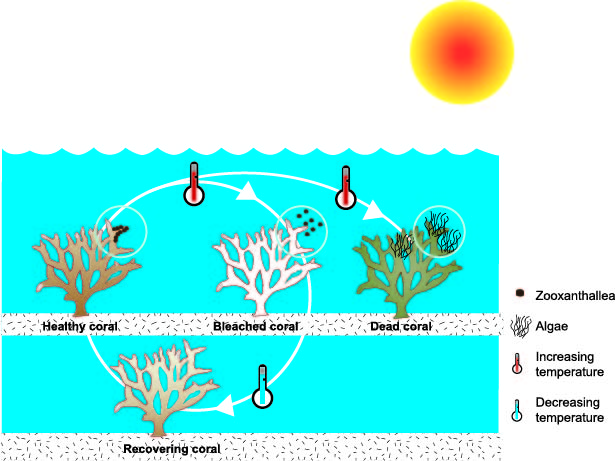
Coral Bleaching
The primary factor determining whether a coral survives a bleaching event or not is the amount of time that it is exposed to elevated temperatures under high light conditions.
In healthy coral, symbiotic algae (zooxanthellae) live within the coral tissue. Algae provide the coral with food and energy as well as their characteristic brown-green colour. Stressful environmental conditions can cause the coral to expel the symbiotic algae, changing the coral colour to white. This whitening of coral is called ‘coral bleaching’. Sometimes corals can recover from bleaching, but if stressful conditions are severe, or persist for a long time, loss of symbiotic algae and the nutrients they provide can lead to coral death. Even when corals do recover, they are vulnerable to diseases and other stress and not always return to full health.
The longer the coral is exposed to a stressor, the greater the chances of mortality. Corals can recover quickly from bleaching events once the sources of stress are removed. In some cases, corals can recover their colour within days. However, each bleaching event weakens the overall health of the coral over time.
In Australia, the Great Barrier Reef is a well known icon bustling with marine life. Unfortunately, also this reef is under pressure from global climate change and other threats. Global bleaching events also occurred on the GBR in 1998 and 2002, but not to the extent of the 2016 and 2017 bleaching events. In 2016, reports indicated severe bleaching on 81% of the reefs in the far northern sector of the GBR and the relatively pristine reefs north of Port Douglas were hit hardest. In 2017, it was the central part of the GBR that was hit hardest. The southern GBR mostly escaped the bleaching, but had to cope with cyclones and Crown-of-Thorn outbreaks, both affecting coral cover.
Almost half of the coral cover on the GBR was lost during the 2016-2017 back-to-back bleaching events and it will take many years for coral to grow back. See 4 page handout with maps and further info.
Sadly, the Great Barrier Reef is now (March 2020) experiencing a third mass coral bleaching event in five years. See latest overview with media and video links from various reliable resources (10 April 2020).
It is time to act now and help save our reefs. You can help monitor the health of corals on your local reefs with our Coral Health Chart or read our fact sheets and learn how you can help safe the reef.


BLEACHING FACTS
Did you know?

Changes of one or two degrees in sea temperature can cause corals to bleach.

Anemones and giant clams can bleach too. They have the same zooxanthellae as corals.

Corals bleach after being exposed for approximately 4 weeks to warmer sea temperatures, but can recover if the water temperature returns back to normal within several weeks.

Mass bleaching events are related to global warming, but low sea temperatures, sedimentation, UV light, fresh water and pollution can also cause bleaching.

Not all corals bleach simultaneously. There are differences within and between species, genera and growth forms. Often ‘fast growing’ branching corals bleach first, while the ‘slow growing’ big boulder corals are more resistant.

After a bleaching event, corals are less able to cope with temperature shifts and diseases, and have reduced growth rates and reproduction.

